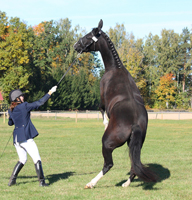Managing your fizzy horse
The term “fizzy” is usually applied to horses and ponies that display over-exuberant behaviour when being ridden. This can be seen as them wanting to go everywhere at a faster speed than the rider, who, when they try to restrain the horse, is rewarded with jogging and possibly spooking, bucking and rearing.
Ultimately, it usually means that the rider is worn out trying to keep the horse under control and fizzy behaviour can be detrimental to performance. There are a number of factors that can result in fizzy behaviour and it is important to explore all possibilities, including feeding.
Management factors
The first step is to ensure that the horse isn’t in pain when being ridden. Ill-fitting tack, tooth abscesses and back or limb injuries are all examples of why some horses become difficult to ride. A thorough examination of the horse and the tack should be carried out by experienced professionals to ensure that pain isn’t the cause of the problem.
The environment is often a contributing factor, with windy days increasing the chance of even the calmest horse shying away from a plastic bag in the hedge. Excitement generated by being in a different environment, such as away at a show or out on a hack, can also be the cause of many problems.
Limited exercise and stabling for long periods are also common reasons for a horse to exhibit fizzy behaviour. If this is the case, addressing the underlying issue by turning out for longer or increasing the amount of exercise is usually the most effective way of solving the problem. However, this isn’t always possible, so ensuring that the diet is based on slow-release energy sources such as the Dengie fibre- based feeds, rather than ‘quick-release’ energy sources, is essential for health and behaviour.
Consider the amount of energy supplied and the type of energy source
There are two areas to consider when feeding fizzy horses – how much energy is consumed and the type of energy sources supplied by the ration.
Energy supply
Providing more energy than your horse needs can result in over-exuberant behaviour and weight gain, regardless of the origin of the energy. In spring and summer, the longer evenings and generally better weather mean that we tend to increase our horse’s workload gradually. It is important not to assume automatically that an increase in workload means the energy or calorie level of the ration needs to be increased, especially if your horse is otherwise looking and performing well.
As a general rule, increase your horse’s workload first, then continue to monitor its body weight and performance to determine if a higher energy ration is necessary. It is also important to remember that grass growth begins in earnest at this time of year and makes more of a contribution to your horse’s ration and, therefore, overall energy intake. Lisa Mancuso has given us an insight into how she found the perfect low sugar & starch diet for her horse Trigger, in our case study: Maintaining Condition without Fizz
Energy source
For fizzy horses and ponies, the ration should be based on slow-release or non-heating energy sources rather than those based on quick-release or heating energy sources.
Sources of quick-release energy are starch and sugars, which are rapidly broken down in the horse’s digestive system, releasing energy quickly. The main source of starch in horses’ diets tends to be cereal grains. Starch is rapidly broken down to glucose, which passes from the digestive system into the bloodstream. The resulting peak in blood glucose is thought to be why fizzy behaviour follows, so keeping starch intake to a minimum is essential.
It might surprise you to learn that the most abundant source of sugar in the horse’s diet is grass, so other sources of sugar that are fed in much smaller quantities – such as molasses – shouldn’t always be assumed to be the cause of fizzy behaviour. An excessive intake of sugar, such as when the horse consumes a lot of fresh spring grass, can result in more over-exuberant behaviour at this time of year.
Did you know that 1kg of grass can supply about 400g of sugar at this time of year, 1kg of hay will typically supply 100g of sugar and 1kg of Dengie Hi-Fi Molasses Free 25g of sugar. However, a horse at grass is more likely to consume about 4kg of sugar in a day easily from grass alone – that’s equivalent to four bags!
Sources of slow-release energy are those based on fibre and oil, which are broken down slowly in the horse’s digestive system so you don’t get the associated large peak in blood glucose, as you would with starches and sugars. Many people under-estimate just how much energy good-quality fibre can contribute to the ration.
Straw is very fibrous and, therefore, not very digestible. This makes straw very useful for horses and ponies that maintain weight very well but, for those in work or that struggle to maintain weight, a more digestible fibre source such as alfalfa or unmolassed sugar beet would be more valuable. Alfalfa naturally has a similar energy or calorie level as a cool or pasture mix, but without the starch, which means that you can feed a fibre-based feed and still meet the energy requirements of most horses and ponies.
Oil contains lots of energy or calories and is a useful way of increasing the horse’s energy intake and a safer alternative to cereals for horses and ponies prone to laminitis or muscle problems such as ERS. Oil provides slow-release energy, so it is ideal for fizzy horses that require additional energy for work or weight gain.

Suitable feeds for fizzy horses
Because fibre and oil provide slow-release energy, they should form the basis of rations for fizzy horses and ponies. For those in light work that are good doers, Dengie Hi-Fi Molasses Free, alongside a broad-spectrum vitamin and mineral supplement or feed balancer, would provide a balanced high-fibre diet that is low in starch, sugars and energy. For horses in work or those needing to put on weight and condition, Dengie Alfa-A Molasses Free or Alfa-A Oil, alongside a performance balancer, would be suitable.
Research has shown that feeding alfalfa and sugar beet together increases the digestibility of the alfalfa so that the horse is able to obtain even more energy from it. Because alfalfa and sugar beet both provide slow-release energy, Dengie Alfa-Beet, which combines both without any other additives or molasses, is another way of increasing the energy intake without using feeds that contain high levels of starch or sugars.
Maximising digestion
Fizzy horses can be very “stressy” individuals, which can cause loose droppings when travelling and competing. These horses also tend to lose weight easily. In these situations, a more comprehensive digestive supplement may be beneficial. Products that combine a prebiotic and yeast, will help to maintain a healthy digestive system at times of stress. They can be used long-term but might also be effective when used for a few days before, during and after a period of stress.
Top tips for feeding fizzy horses
- Don’t always assume that feeding is the cause of the problem. Check out other management factors as well.
- Don’t supply more energy than your horse needs to maintain weight at the level of work you are doing
- Base the ration on slow-release energy sources, such as the Dengie fibre feeds. Just choose a fibre feed according to body weight and workload, then top up with a broad-spectrum vitamin and mineral supplement.
- If you need to promote weight gain, feed little and often, gradually increasing the energy or calorie content of the ration.
- Consider the use of digestive supplements to maximise fibre digestion for poor doers.
For friendly feeding advice call the Dengie Feedline 01621 841188.




